#Rhipidura
Explore tagged Tumblr posts
Text

Rufous Fantail (Rhipidura rufifrons), family Rhipiduridae, found in northern and eastern Australia
photograph by oz_bird_photography
279 notes
·
View notes
Text

[2963/11080] Dimorphic fantail - Rhipidura brachyrhyncha
Order: Passeriformes Suborder: Passeri Superfamily: Corvoidea Family: Rhipiduridae (fantails)
Photo credit: Jacques Erard via Macaulay Library
#birds#Dimorphic fantail#Passeriformes#Passeri#Corvoidea#Rhipiduridae#Rhipidura#birds a to z#undescribed#25% - 50%
105 notes
·
View notes
Text

Little sketchbook doodle of a pīwakawaka.
#art#my art#traditional art#coloured pencils#wildlife art#archosaurs#dinosaurs#theropods#coelurosaurs#maniraptorans#birds#passerines#rhipidura#rhipidura fuliginosa#pīwakawaka#new zealand fantail#queue
27 notes
·
View notes
Text

White-throated Fantail
22 notes
·
View notes
Text

October 13, 2024 - Kadavu Fantail (Rhipidura personata) These fantails are found in the dense underbrush of forests, usually near water, on the islands of Kadavu and Ono in southern Fiji. Usually foraging in mixed-species flocks, they feed on small insects, capturing them in the air or picking them from foliage. While not much is known about their nesting behavior, they have been recorded breeding in October and November and building small cup-shaped nests with hanging tails from fine fibers. They are listed as Near Threatened by the IUCN due to habitat loss and degradation in their tiny range caused by fires and agriculture.
64 notes
·
View notes
Text

Day 10 of Pied Month! I had 2 puns for the Malaysian Pied Fantail - Transtail, then I thought of Pantail which was much better
Reference photo by Tony Castro
(in the low-effort style, college is ending soon so I'll have more time to do art)
#pride month#pied month#trans#trans pride#pansexual#panromantic#malaysian pied fantail#fantail#rhipidura javanica#rhipiduridae#passeriformes#ornithology#bird#birb#birds#bird art#art#digital art#artists on tumblr#wauk wauk
25 notes
·
View notes
Photo
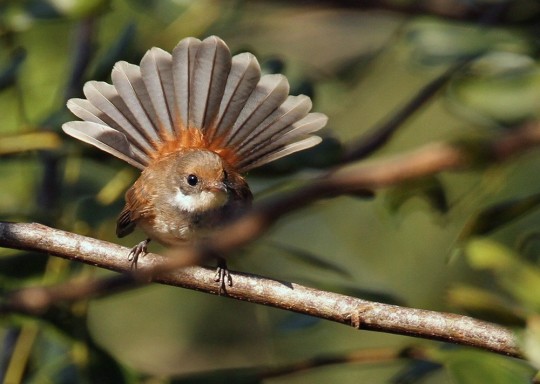
Arafura Fantail (Rhipidura dryas)
© Lars Petersson
206 notes
·
View notes
Video
April, 2023 Taupo 18 by ArdieBeaPhotography Via Flickr:
0 notes
Text

Rhipidura leucophrys o abanico lavandera, es un paseriforme de la Familia Rhipiduridae y del genero Rhipidura.
Es una especia nativa de Australia, Nueva Zelanda, Indonesia e Islas Salomón.
Es de color blanco y negro con pico fino y patas largas. Negro arriba, blanco abajo, con ceja blanca estrecha. Habita en parques, granjas y pastizales, al posarse mueve la larga cola de un lado a otro. su canto y llamada son muy agradables.
1 note
·
View note
Text

some birds, drawn with sharpies and white ink.
Willie-Wagtail (Rhipidura leucophrys), Torresian Crow (Corvus orru).
#art#traditional art#sketch#original art#illustration#animal art#birds#birb#bird art#australian animals#australian birds#willie wagtail#torresian crow#crow#raven#my art
43 notes
·
View notes
Text

Blue-headed Fantail (Rhipidura cyaniceps), family Rhipduridae, Sierra Madre, order Passeriformes, endemic to the Philippines
photograph by Abadicio Albert
1K notes
·
View notes
Text
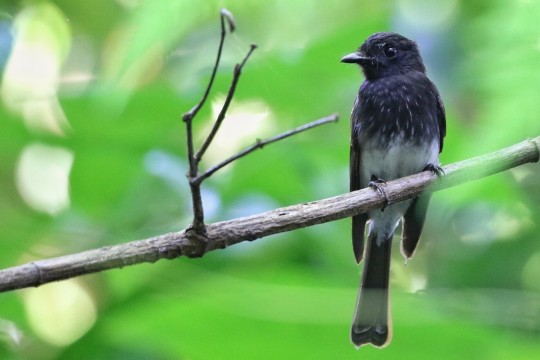

[2523/11080] Cockerell's fantail - Rhipidura cockerelli
Note: Clements has split this bird into two species: the white-winged fantail R. cockerelli (top) and the white-gorgeted fantail R. coultasi (bottom), whilst the IOC considers them to be the same species.
Order: Passeriformes Suborder: Passeri Superfamily: Corvoidea Family: Rhipiduridae (fantails)
Photo credit: Joshua Bergmark/Corey Callaghan
#birds#Cockerell's fantail#Passeriformes#Passeri#Corvoidea#Rhipiduridae#Rhipidura#birds a to z#undescribed#white-winged fantail#white-gorgeted fantail
91 notes
·
View notes
Text
Actually while I'm still a bird blog (literally just for today) here's some other birds I'm fond of/think would be GREAT in Skyjacks:

Willie Wagtail (Rhipidura leucophrys)
Tiny, adjustable eyebrows, fan tail, fantastically acrobatic fliers. Two kinds of noises: angry shouting and beautiful singing. Diet is primarily insects but they have been known to eat carrion of far larger animals. Not afraid of humans. Made mostly of audacity: will often attack much larger birds including magpies, ravens and occasionally even osprey (sea eagles) or wedge-tailed eagles.

Currawong (Strepera sp.)
Three species of absolute clown disguised as dapper goths. Very clever and capable of bastardry: wild populations have been documented unzipping bags to get at the contents. All round omnivore. Social. Soup dragon noises.
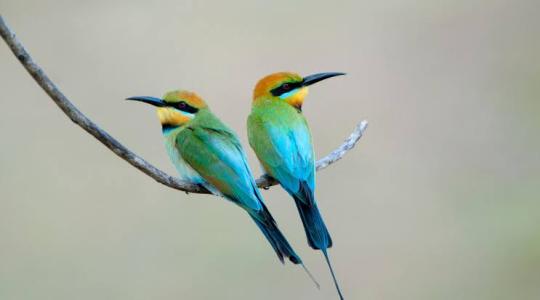
Rainbow bee-eater (Merops ornatus)
Rainbow, eats bees (and other insects, but especially bees). Migratory, can fly far distances for a little bird. Makes and then nests in underground burrows. Very social. Makes delightful prrt noises and exhibits some very cute huddling behaviour.

Red-tailed black cockatoo (Calyptorhynchus banksii)
Large, loud and social. Shy with humans but not absent from urban and suburban areas. Dangerous if you happen to be a delicious seed pod, or item that looks fun to chew on. Capable of high flying, rarely comes down to the ground (mostly hangs out in trees). A herald of coming rains, according to old farmer's tales. Brains. Incredible aesthetic really.

Splendid fairywren (Malurus splendens)
This tiny man is in fact more blue in person, (juvenile and female individuals being brown with a splash of blue on the tail). He flirts by offering flower petals and fancy flying. He's also a good dad. Always moving, fast takeoff and strong flight (but only in short bursts). Like all adorable round birds, very territorial.
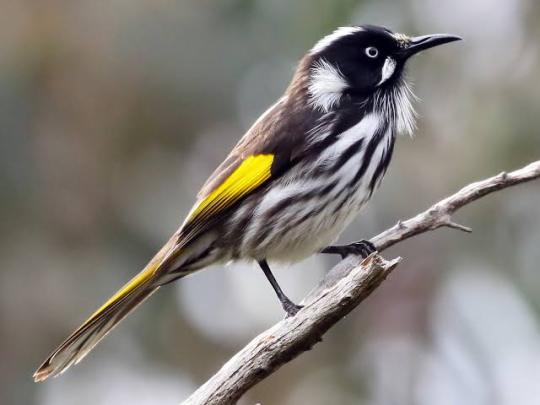
New Holland honeyeater (Phylidonyris novaehollandiae)
Small, social bird with dignified sideburns who subsists primarily off of sugar (with a side of insects and arachnids). Mobile, talkative, and known to gang up on larger birds, such as wattlebirds (below). Nimble fliers, but tend to navigate a flowering bush from the inside. Looks like an electric type pokémon.
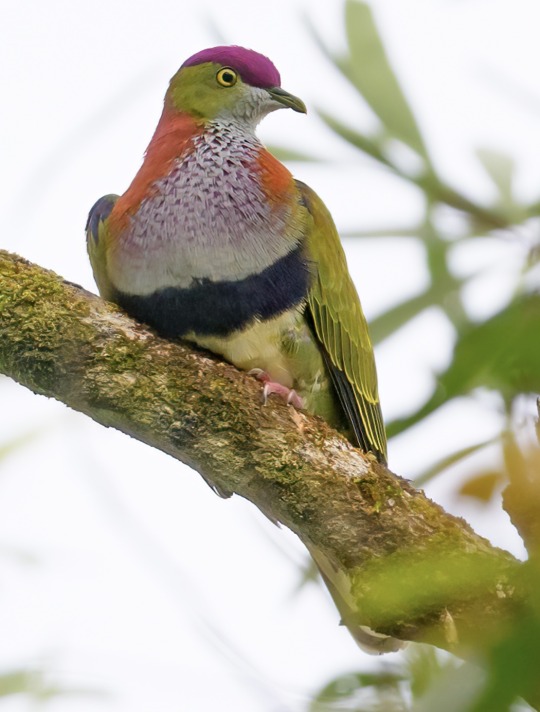
Superb fruit dove (Ptilinopus superbus)
Medium-small pigeon with an absolutely unrealistic colour palette (yet impressively camouflaged). Indeed superb. Also a dove that eats fruit. Not great at building nests. Migratory or nomadic but sneaky about it: possibly at night, as they (unfortunately) occasionally collide with lighthouses.

Pacific baza (Aviceda subcristata)
Looks as though a wizard has turned a cuckoo into a bird of prey in a futile attempt to teach it the meaning of hard work. In fact a medium sized, crested hawk. An omnivore: hunts everything from insects to reptiles to smaller birds, but also actively eats fruit. Rumoured to be able to mimic frog-calls, which coaxes the frogs to respond in turn. Pretty chill and, like many other hawks, social. Documented aerial somersaulter. Also not the greatest at nest building.

Red wattlebird (Anthochaera carunculata)
Not the prettiest, but interesting to watch. Large honeyeater and one of the few birds I am convinced has retained awareness of being a dinosaur. Loud about it, either with a gutteral cluck or lovely singing. Glides as much as flies, though they are perfectly capable of it. A decent climber, nimble. Will throw it's weight around with both smaller and larger birds. Unclear if it entirely understands it's place in the food chain.

Southern boobook (Ninox boobook)
A small, compact, cute and otherwise plain owl, but with very striking eyeliner. Does well in suburban areas. Named for the distinct noise it makes, though is (as most owls are) a totally silent flier. Feeds mostly on insects and small mammals but is also capable of catching bats.
62 notes
·
View notes
Text

Birds daytime
-昼の鳥撮り-


Night heron ゴイサギ / Common myna インドハッカ / Rhipidura javanica ムナオビオウギビタキ
Fujifilm X-T5 / Tamron 150-500mm f5-6.7
photo by yotarosuite
#birdlovers#bird photography#bird#birds#fujifilm photography#fujifilm x series#fujifilm xt5#bangkok#thailand#yotarosuite
8 notes
·
View notes
Text

June 4, 2024 - Sooty Thicket-Fantail (Rhipidura threnothorax) These fantails are found in lowland forests in New Guinea and several nearby islands, often around streams. They eat small insects, capturing prey in short flights and picking it from surfaces near, or sometimes on, the ground. They also follow larger birds including cassowaries and brush-turkeys, feeding on fleeing insects. Breeding from at least January to August, they build small cup-shaped nests with long tails in forked branches in the undergrowth.
72 notes
·
View notes
Text
Cooleenup Island Species List - BIRDS - June 9th to 11th 2023
12C-18.5C, 2.4mm-12.5mm rain, strong wind on Sunday
(taxonomic order and nomenclature follows Clements, version 2022)
Pacific Black Duck Anas superciliosa Mallard Anas platyrhynchos Common Bronzewing Phaps chalcoptera Laughing Dove Spilopelia senegalensis Eurasian Coot Fulica atra Silver Gull Chroicocephalus novaehollandiae Caspian Tern Hydroprogne caspia Greater Crested Tern Thalasseus bergii Australasian Darter Anhinga novaehollandiae Great Cormorant Phalacrocorax carbo Pied Cormorant Phalacrocorax varius Great Egret Ardea alba White-faced Heron Egretta novaehollandiae Australian Ibis Threskiornis molucca Yellow-billed Spoonbill Platalea flavipes Swamp Harrier (immature) Circus approximans White-bellied Sea-Eagle Haliaeetus leucogaster Sacred Kingfisher Todiramphus sanctus Galah Eolophus roseicapilla Little Corella Cacatua sanguinea Australian Ringneck Barnardius zonarius Redcap Parrot Purpureicephalus spurius Splendid Fairy-wren Malurus splendens Red Wattlebird Anthochaera carunculata Spotted Scrubwren Sericornis maculatus Inland Thornbill Acanthiza apicalis Western Gerygone Gerygone fusca Black-faced Cuckooshrike Coracina novaehollandiae Gray Butcherbird Cracticus torquatus Australian Magpie Gymnorhina tibicen Gray Fantail Rhipidura albiscapa Australian Raven Corvus coronoides Scarlet Robin Petroica boodang Welcome Swallow Hirundo neoxena Tree Martin Petrochelidon nigricans Silvereye Zosterops lateralis
2 notes
·
View notes
